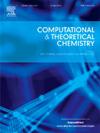Mechanistic insights into NiMn bimetallic synergy driving efficient CO₂ to CH4 conversion
IF 3
3区 化学
Q3 CHEMISTRY, PHYSICAL
引用次数: 0
Abstract
CO₂ methanation represents a critical strategy to address environmental and energy challenges, though its reaction mechanism remains poorly understood. This study establishes a Mn-doped Ni (1 1 1) bimetallic catalytic model and employs density functional theory (DFT) calculations to systematically elucidate the unique mechanism of Ni![]() Mn synergistic effects. At the CO₂ activation stage, Mn doping shortens the metal-O bond length from 2.34 Å to 2.08 Å and alters the active site charge from +0.036 e to −0.147 e, enhancing CO₂ adsorption and dissociation through d-orbital hybridization and charge redistribution. Concurrently, geometric modulation of Ni electronic structures reduces the rate-determining step activation energy to 1.28 eV. Through comparative analysis of three reaction pathways (CO₂⁎ dissociation followed by CO⁎ hydrogenation, HCOO⁎ intermediate reduction, and COOH⁎ intermediate reduction), the optimal reaction channel has been identified. This work provides theoretical guidance for designing efficient CO₂ conversion catalysts and offers predictive insights for subsequent experimental validation.
Mn synergistic effects. At the CO₂ activation stage, Mn doping shortens the metal-O bond length from 2.34 Å to 2.08 Å and alters the active site charge from +0.036 e to −0.147 e, enhancing CO₂ adsorption and dissociation through d-orbital hybridization and charge redistribution. Concurrently, geometric modulation of Ni electronic structures reduces the rate-determining step activation energy to 1.28 eV. Through comparative analysis of three reaction pathways (CO₂⁎ dissociation followed by CO⁎ hydrogenation, HCOO⁎ intermediate reduction, and COOH⁎ intermediate reduction), the optimal reaction channel has been identified. This work provides theoretical guidance for designing efficient CO₂ conversion catalysts and offers predictive insights for subsequent experimental validation.

NiMn双金属协同作用驱动CO 2到CH4有效转化的机理研究
二氧化碳甲烷化是解决环境和能源挑战的关键策略,尽管其反应机制尚不清楚。本研究建立了mn掺杂Ni(1111)双金属催化模型,并运用密度泛函理论(DFT)计算系统阐明了NiMn协同效应的独特机理。在CO₂活化阶段,Mn掺杂使金属-o键长度从2.34 Å缩短到2.08 Å,使活性位点电荷从+0.036 e改变到−0.147 e,通过d轨道杂化和电荷重分配增强了CO₂的吸附和解离。同时,Ni电子结构的几何调制将速率决定阶跃活化能降低到1.28 eV。通过对三种反应途径(CO₂解离后CO加氢、HCOO中间还原、COOH中间还原)的对比分析,确定了最佳反应通道。这项工作为设计高效的CO₂转化催化剂提供了理论指导,并为后续的实验验证提供了预测性见解。
本文章由计算机程序翻译,如有差异,请以英文原文为准。
求助全文
约1分钟内获得全文
求助全文
来源期刊

Computational and Theoretical Chemistry
CHEMISTRY, PHYSICAL-
CiteScore
4.20
自引率
10.70%
发文量
331
审稿时长
31 days
期刊介绍:
Computational and Theoretical Chemistry publishes high quality, original reports of significance in computational and theoretical chemistry including those that deal with problems of structure, properties, energetics, weak interactions, reaction mechanisms, catalysis, and reaction rates involving atoms, molecules, clusters, surfaces, and bulk matter.
 求助内容:
求助内容: 应助结果提醒方式:
应助结果提醒方式:


